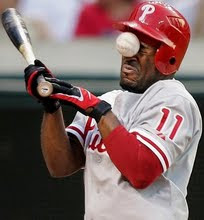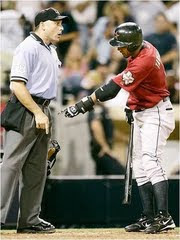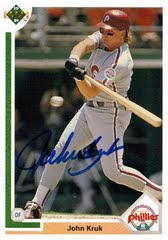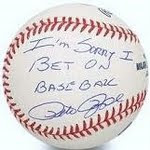[A NOTE FROM DME: Dear readers, I have to apologize. While creating a new post about Jonny Gomes earlier today, I inadvertently deleted the first two paragraphs of this post and published the changes. As a result, the introduction and most of the funny bits from this post are missing. I deeply apologize for the incoherent inconvenience that may result. What follows are the reminants of what I did not delete and the meat of the assertion that Jonny Gomes is similar to Adam Dunn in more ways than one...enjoy!]
...Dusty Baker hates clogging up the bases with walks.
Out goes Adam Dunn, in comes Jonny Gomes. While both strike out at comparable rates (Dunn strikes out 32.5% of the time, Gomes does it 30.9% of the time) and have prodigious power (Dunn has a .275 ISO, Gomes has a .272 ISO), Gomes walks almost exactly half as much as Adam Dunn (8.9% versus Dunn's monstrous 17.3% walk rate). Even though Adam Dunn doesn't exactly miss Cincinatti, I am fairly certain stat-head Reds fans who live in their mother's basements miss his robotic annual production of 100 BBs and 40 HRs plenty...even if he never tried very hard.
But let's not be too hard on Gomes here. A marginally better than league average walk rate is nothing to sneer at when paired with legitimate power (.230 career ISO) and defense skills that are only half as crappy as his predecessor. In fact, in less than half as many PA's as Adam Dunn this season, Jonny Gomes has been, when you combine and compare offensive and defensive production, exactly half as valuable as Adam Dunn this season. Extrapolated, that insinuates that two have the same production rate per game for their respective teams. Such is true for 2009, but is this a legitimate expectation for 2010 and going forward?
Jonny Gomes has no doubt been a disappointment since his breakout 2005 campaign. In the following season, his BA plummeted (as should be expected from a person who strikes out 1/3 of the time) from .282 to .216. Bolstered by an 11 HR April, Gomes' season ISO remained quite high for 2006, but declined from .253 to .216 (league average is around .155). Gomes "regression" was so drastic that he was given a largely limited role in the majors (and banished mostly to the minors) from mid-2006 through last the end of last season, when he was non-tendered by the Rays. The Reds gaves Gomes a minor league contract with a chance to prove he still had something less to contribute and he surely provided them with a lot of bang for their buck (.264/.339/.540, with 20 HR and 49 RBI over 298 PA).
So what is with the roller coaster ride that is Gomes? The answer is largely attributable to two factors. The first is what we would traditionally call "a giant hole in his swing" (0.36 BB/K, 70.7% career contact rate against an 80.5% league average). The second is an inability to hit right handed pitching (.225/.312/.448 line vs RHP, .271/.368/.513 line vs LHP, a sharp .121 point difference in OPS).
These two factors have led to violent oscillations in Gomes' BABIP by season. Here is Gomes BABIP since (and including) 2005: .360, .253, .332, .200, .307. His career BABIP is .296. Such inconsistency is expected from a guy who strikes out three times as much as he walks because it makes the player more prone to extended slumps and more exposed to BA fluxations in the red (logically, if a player Ks a lot and has a poor BABIP over a period of time, the BA is going to fall from ugly, but acceptable to sub-terrible >> check out Dan Uggla's numbers from the first half of this season). However, Jonny Gomes, despite all of the inconsistencies and headaches has made large improvements in his game each of the past four seasons that make the likelihood that he sustains his steps forward on the season more Russell Branyan like and less Corey Patterson like.
Since his full time debut in 2005, Jonny Gomes has cut down the major league strikeout rate a couple percentage points, while settling in at a walk rate within the 9% range each of the past three seasons. After taking some steps back with a K% of 36.2% in 2006, Gomes took a big step forward in 2008 and again in 2009, reducing the K rate to the 30-31% zone. These gains weren't noticed much in limited and sporadic action in 2008 because of a .200 BABIP. Guys like Gomes who strikeout a lot (and especially ones who do not have the best control of the strike zone) make terrible terrible back up players because they have no chance to get into any rhythm during the season, which only exacerbates their weaknesses. Gomes steps forward in strikeout rates has largely been attributable to a change in his approach at the plate. Although Gomes is taking about 5% more swings at pitches than he was as a full time player in Tampa, he is also making 5% more contact with those swings than he was before (largely because he is swinging at more pitches inside of the zone and, compared to the last two seasons, swinging less at pitches outside the zone). Gomes has also cut down the frequency with which he takes a hack at the first pitch he sees from a below average 60.2% rate in 2005 to a slightly above league average 58.7% rate in 2009.
Oh yeah, and you know that lefty-righty split? Gomes has a .871 OPS in 174 PAs against righties this season (.894 OPS vs lefties). Gomes' BABIP vs righties is a bit high at .321, but even if that settles down to the .300 range (which it most likely will, going forward), Gomes would be producing a quality .800+ OPS line against RHPs.
All of these signs show that Gomes' steps forward are not simply the byproduct of luck, but rather legitimate improvements in peripherals and approach. The results have been nothing short of gravy for the Reds. Fangraphs values Gomes' limited playing time production at $3.6 million (largely attributable to his +1 wins in offensive production); yet he's only getting paid somewhere between $600K and $800K. Whether or not Gomes continues his steps forward next season remains to be seen. At 29 years old, the ceiling is seemingly limited, but he's already proven that he possesses the necessary power for success and has shown himself increasingly adequate in the other aspects of the game over time (albeit, often hindered by the forces of bad luck). Gomes is under team control for two more years before he is eligible for free agency, so the Reds probably figure to tend Gomes' a contract this off season. It will be interesting to see what kind of numbers Gomes puts up in a full season playing LF.
What do you think Gomes 2010 looks like if given an opportunity as a full starter again? Will he be continue to be Adam Dunn with less walks for The Reds or will Gomes regress to his post-2005 numbers? Either way, this experiment shouldn't cost the Reds too much next season and they will probably, therefore, take the risk of starting him in LF in 2010 as they attempt to rebuild their tattered franchise.
Is Jonny Gomes Adam Dunn Lite?
Posted by
David "MVP" Eckstein
on Tuesday, September 22, 2009
Labels:
Adam Dunn,
Fantasy Outlook,
Jonny Gomes







2 comments:
I did not know we at GOI believed in "rhythm".
If he can get his z-contact to around 78%, i like him going forward
Lots of good stuff in this article. I agree with you on Gomes improvements. I've always seen his potential as very high. In an article last winter I called him potentially the next David Ortiz and he is getting very close to making me look smart.
Post a Comment